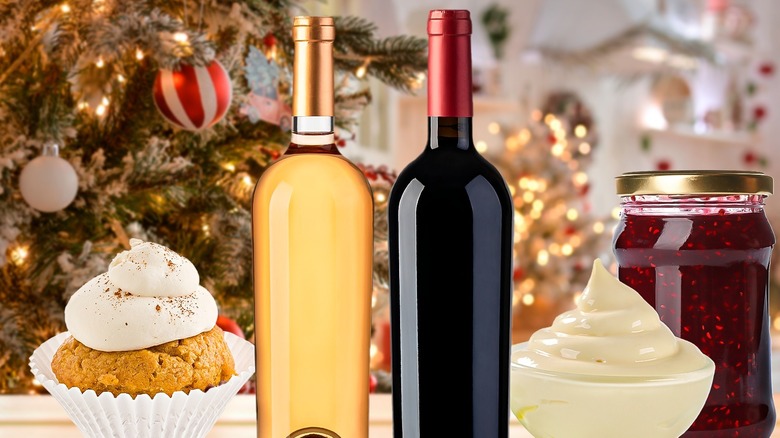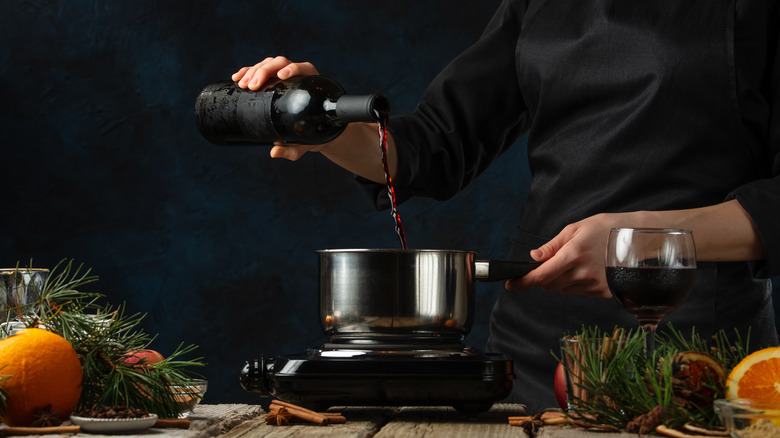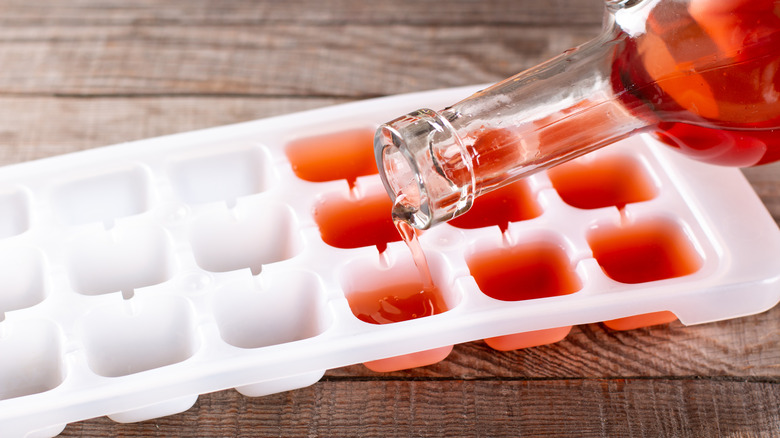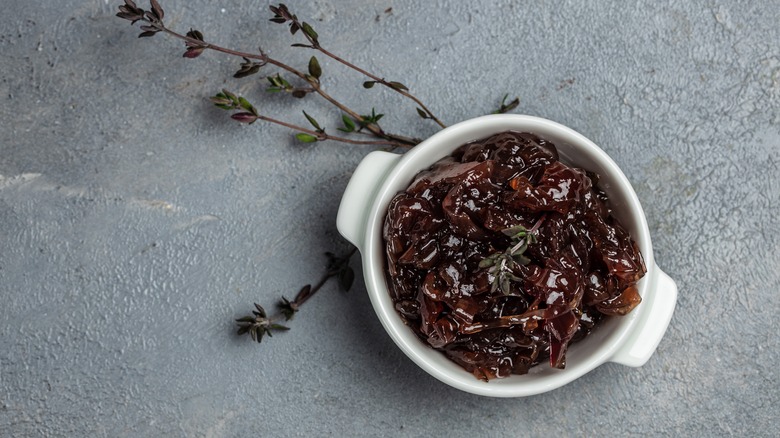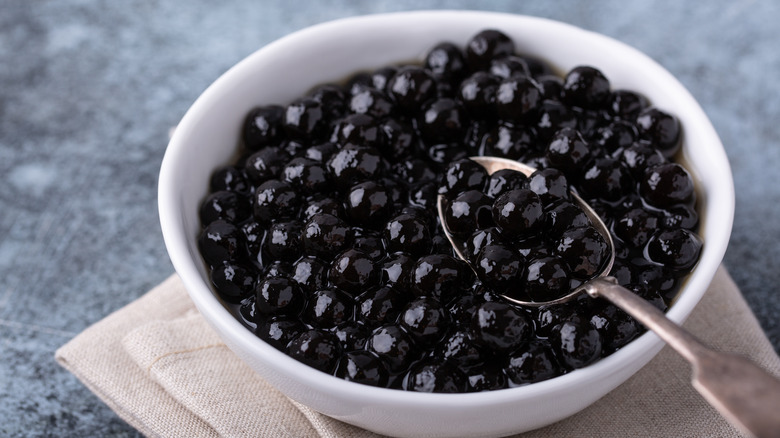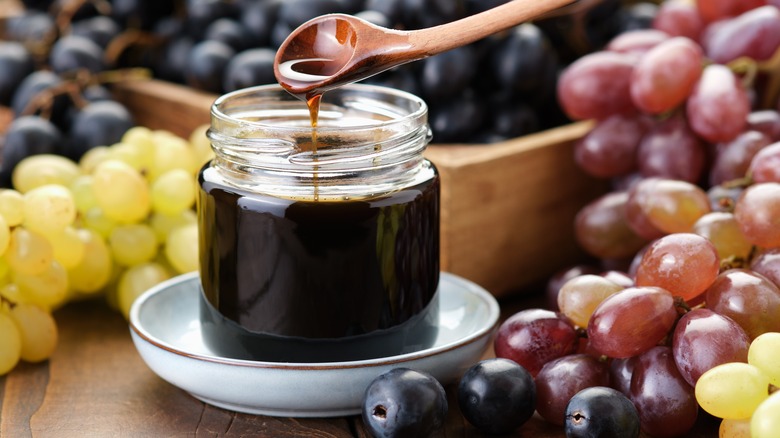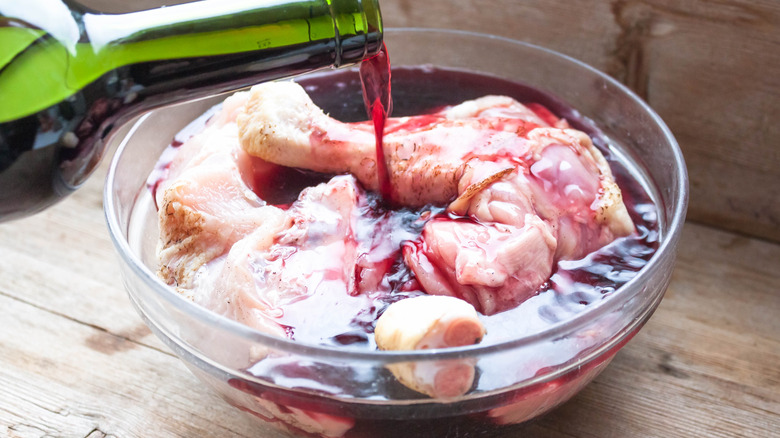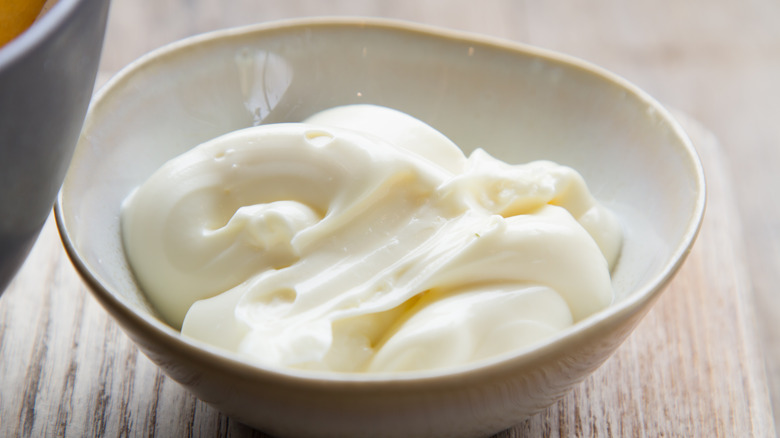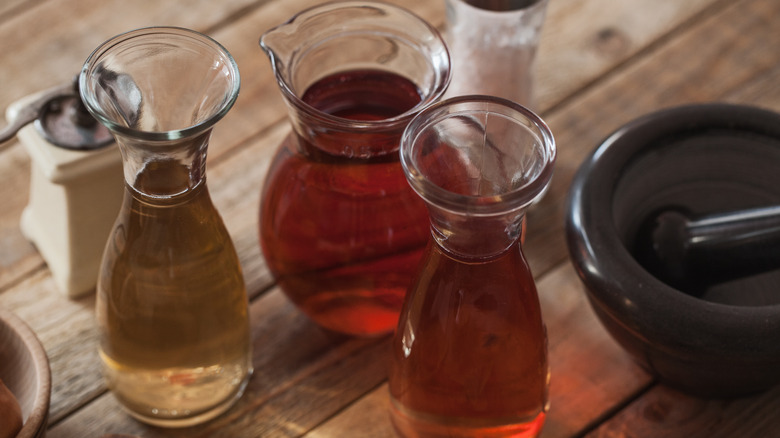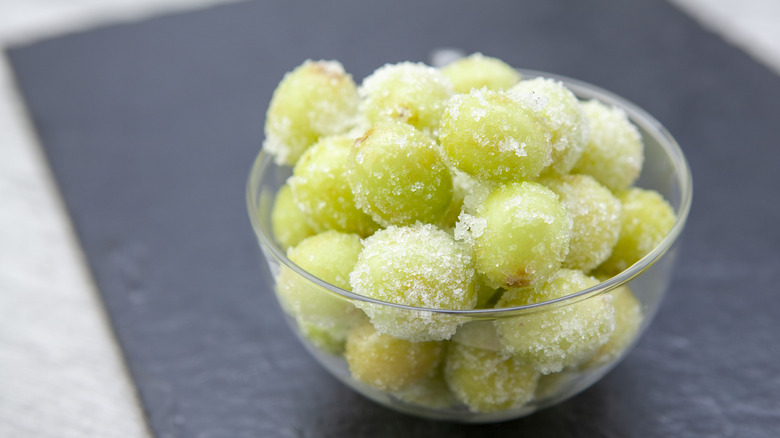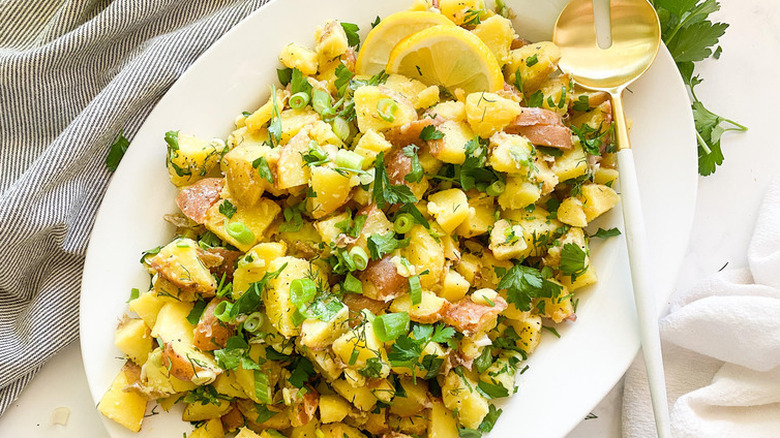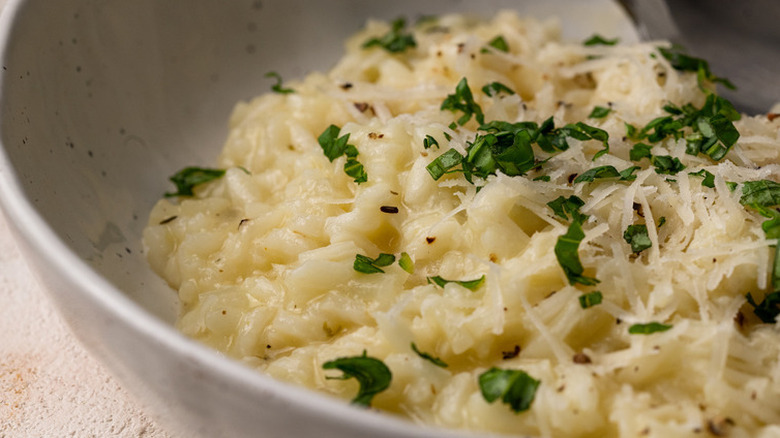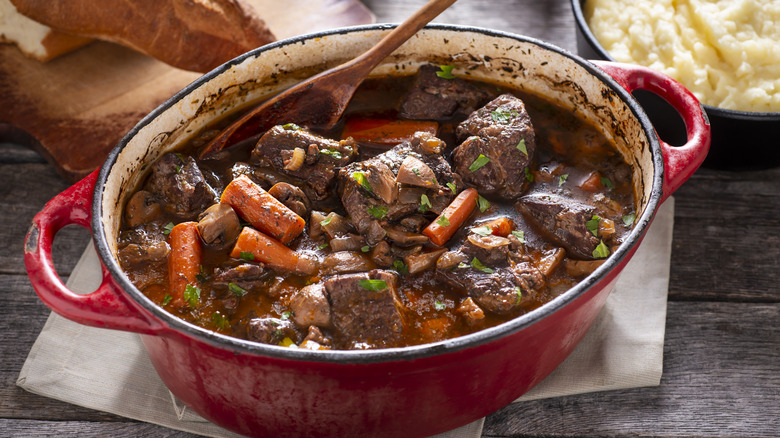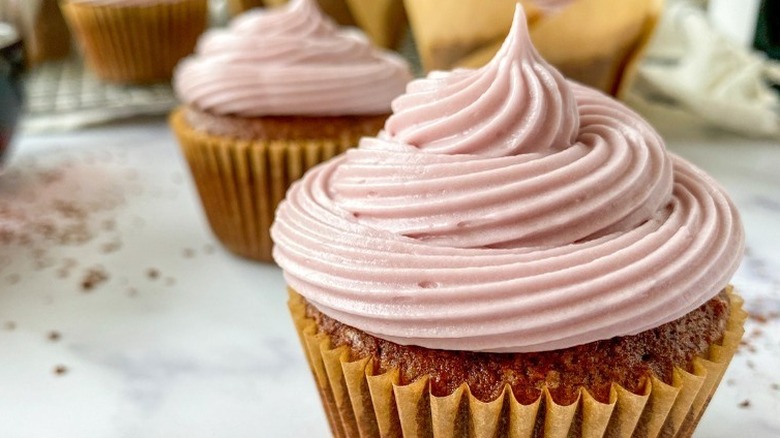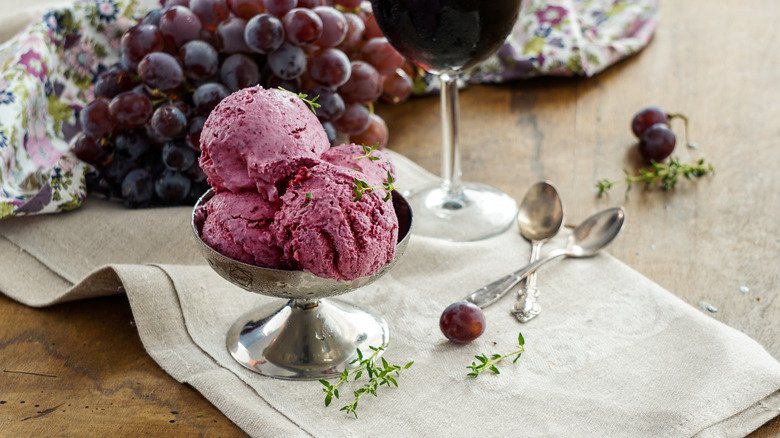15 Best Uses For Leftover Wine Other Than Drinking It
We get it: You read the headline of this article and thought to yourself, "What the heck is leftover wine?" Believe it or not, there are many reasons you could find yourself with a little wine left in the bottle. Maybe you picked up a bottle of Chardonnay for a book club meeting, but you're more of a red wine drinker. Perhaps you cracked open a Pinot Noir a week ago, drank a glass, and put the three-quarters-full bottle back in the wine cabinet. Maybe your boss gifted you an expensive bottle of Beaujolais, which you realized is absolutely undrinkable after one taste.
You might feel like you're in a bit of a pinch if you're stuck with leftover wine. Of course, you could drink it, but wine's taste changes after opening, and pouring it down the drain is wasteful. While you could offer someone a half-empty bottle of wine, that's not exactly the classiest move.
If you're looking for ways to use up leftover wine that don't involve drinking it, you've come to the right place. Both red and white wines are fantastic for cooking (yes, it is safe to use old wine for cooking), adding bright flavor to anything they touch. Wine also has properties that come in handy in some unexpected ways, like fixing separated mayo and creating delicious, elevated baked goods. When life gives you lemons, make lemonade. When life gives you leftover wine, try one of these tricks.
Use wine for poaching
Poaching has several definitions, but in the kitchen, poaching means directly submerging an item of food in hot liquid to cook it. There are a number of advantages to poaching — it allows food to cook evenly all over, produces a delicate texture, and depending on the liquid used, infuses the food being cooked with the flavor of the liquid. In theory, just about any liquid can be used here, depending on the type of food you're cooking and the way you want your food to taste, but using wine for poaching is a fantastic way to bring a dish to the next level ... and use up that half-empty bottle lurking in the pantry.
You can poach just about anything in wine — beef, poultry, pork, eggs, even fruits and vegetables. If your leftover vino comes in a few different varieties, think about what you're cooking. There are no rules in your own kitchen, but in general, red meats will pair best with red wines, while lighter meats like chicken or turkey pair best with white. Eggs can go either way, and the sky's the limit when it comes to fruits and veggies. Consider using a deep red wine to poach beef tenderloin, or whip up some poached peaches in white wine for a guaranteed after-dinner crowd-pleaser.
Reduce it for pan sauce
Wondering what to do with all those drippings and bits of charred onion and garlic stuck to the bottom of your pan after cooking? Don't scrape the pan and throw it away! Use those little goodies with the last bit of yesterday's wine, along with some butter and fresh or dried herbs, to create an effortlessly elevated wine sauce to complement your meal. While you don't need wine for a pan sauce, it adds a bold touch to a finished dish — when red wine is reduced in the pan, the wine's liquid begins to evaporate as sugars condense and caramelize, leaving a thicker, sweeter liquid with a luxurious, high-viscosity consistency.
Pan sauce might sound labor-intensive, but it only takes a few minutes and is a trick every amateur chef should have up their sleeve. Start by adding leftover wine and a fat (such as butter or olive oil) to the pan with the leftover bits of food. Bringing everything to a simmer, carefully deglaze the bits by scraping the pan. Add items like fresh herbs, dried seasonings, or stock if you like. Let it simmer until the sauce has thickened to your liking, and voilà — you've got an easy, tasty pan sauce to accompany your meal.
Freeze it for later
Many recipes call for wine, but if you're not much of a wine drinker, you probably don't want to spend money on a whole bottle of wine for a recipe only requiring a little splash. Here's a hack: Instead of dumping old wine down the drain, freeze it. Once wine is opened and exposed to oxygen, its flavor changes. However, if you freeze wine shortly after opening, its flavor is preserved. For easy storage, pour the wine into an ice cube tray so you have individually portioned cubes ready to go at a moment's notice.
When the time comes to use your frozen wine, you may wish to allow the cubes to thaw out into liquid form again. This is useful if you're going to be using the leftover wine in a marinade or dressing. In some cases, you may be able to add the cubes to your dish while still frozen, which is usually the case if you're adding leftover wine to a recipe that requires high heat, such as a stew or pan sauce. Alternatively, use wine ice cubes to keep your sangria cool, or to make wine smoothies without watering everything down.
Infuse jam with wine
In cooking, wine is most often used to add deep, rich flavors to savory dishes. However, there are a number of sweet foodstuffs that benefit from the addition of wine. Wine-infused jam presents a prime example. You don't need much liquid for this recipe, so it's a great way to repurpose wine instead of throwing it out. Infusing jam with wine is as simple as combining 2 parts sugar, 2 parts fruit, and 1 part wine along with any desired spices, seasonings, or sweeteners, and boiling it all together until the liquid is reduced and a jelly-like consistency is achieved.
Not sure what type of wine to pair with different fruits? Experimenting is part of the fun, but if you're unsure, start by pairing red wines with red fruits and berries (think cherries, raspberries, and plums) and white wines with lighter fruits like pears and peaches. You'll end up with an elevated, complex jam guaranteed to be a new fave, whether spread on an English muffin, stuffed inside some baked Brie, or added to a charcuterie board.
Amplify boba pearls
Boba tea has exploded in popularity in recent years. What's not to love about a milky tea studded with chewy tapioca pearls? The tapioca beads are a big part of boba's appeal for many people, and their use is not limited to bubble tea. These days, you can find the pearls decorating everything from upscale cocktails to parfaits. Bubble tea pearls are made from tapioca, which gives them a gelatinous, gummy texture, but very little flavor on their own.
Tapioca beads are sometimes steeped in flavored liquid to upgrade their taste. At home, you can steep pre-packaged pearls in any liquid you like, including superfluous wine. Simply add your vino of choice to a saucepan and bring it to a boil, then add the bubble tea pearls, crank down the heat, and allow the beads to simmer in the hot wine until the signature chewy texture is accomplished. All kinds of wine can be used to amplify homemade boba pearls. Experiment with different types and see what works best for your creations.
Make wine syrup
Flavored syrups are a fantastic way to elevate everything from coffee and cocktails to dressings and marinades. If you've ever set foot in an upscale cocktail bar, you've almost certainly seen a drink or two that includes house-made syrup of some kind — but you don't have to strap on your high heels, do your hair, and trot down to that hot new speakeasy to have a drink made with fancy simple syrup. It's incredibly easy to whip up at home, and if you're stumped on what kind of syrup to make first, a syrup made with leftover wine is a good place to start.
Making wine syrup on your stovetop is as easy as combining 1 part wine and 1 part sugar and reducing the mixture in a saucepan over low heat until a viscous, syrupy consistency is reached. Any kind of wine can be used, and you can add in citrus zest, cinnamon sticks, or fresh herbs for more intricate flavors. Once finished, adding wine syrup will do wonders for your drinks, enhancing diverse tipples with rich, deep flavor.
Add wine to a marinade
One of wine's best qualities is complexity. No two varieties are exactly alike — the differences between varying wines are undeniable. It's this intricacy that makes wine a unique and exciting element to cook with. When it comes to cooking meats, leftover wine can be put to work in a marinade for dazzling results. As little as a splash of leftover wine can take a marinade from zero to 100 in a flash.
Similar to the science of pairing drinking wines with different foods, it's important to know which types are the best wines to use in marinades for steak, chicken, and pork, or for other meats. Most of the time, white wines will pair best with marinades for seafood and white meat, while reds serve to elevate red meat. To make a marinade with old wine, combine the wine with ingredients like oil, garlic, herbs, and whatever else you feel will pair well with the meat and wine available. Allow your meat to soak in the marinade for at least an hour, or overnight for maximum flavor.
Fix separated mayonnaise
Ever heard the phrase "oil and water" used to describe two vastly different people or things that just don't mesh together? If you've ever combined oil and water, you know it's accurate. The water molecules actually repel oil molecules. This phenomenon explains why emulsified mixtures like mayonnaise, both store-bought and homemade, can separate into layers. This doesn't necessarily mean the mayo is spoiled and is no longer usable, but separated mayonnaise certainly isn't the most aesthetically pleasing condiment in the fridge. So what can you do?
There's a super simple solution to fix separated mayonnaise, and if you have a few sips of white wine left in the bottle from last week's movie night, you can kill two birds with one stone. Add a splash of white wine to a few tablespoons of separated mayo and whisk the mixture together until the mayo is thick, smooth, and consistent. White wine will work best for preserving the tangy mayo flavor, and will add a hint of the wine's qualities to the mix as a tasty lagniappe.
Turn wine into vinegar
If you've got a lot of patience and not much of a taste for wine, you can make red wine vinegar to eliminate waste and conjure up a signature vinegar blend. Making vinegar with old wine requires only two things. First, you'll need to have some vinegar on hand, and it needs to be raw, unpasteurized vinegar containing a "vinegar mother" — a gelatinous mass of edible live bacteria produced in the fermentation process. The mother is critical for transforming alcohol into vinegar.
Second, you'll need leftover wine. Simply pour the live vinegar and leftover wine in a jar, and cover it with a cheesecloth or thin-knit paper towel so that some air can interact with the liquid. Let the vinegar mixture sit in a cool, dark space for a good long while — it should be usable after eight weeks. Once finished, homemade red wine vinegar can be used however you'd use regular vinegar.
Amp up frozen grapes
Champagne can be one of the wines that gets discarded the most. Once open, a bottle of sparkling wine will only last three to five days, and loses most of its effervescence after just a few hours. It's easy to overestimate how much bubbly guests will consume at a bridal shower or New Year's Eve soiree, and unfortunately, if a bottle is uncorked but not polished off, it's usually tossed. Champagne can be used in several of the hacks listed in this article, but one of the best ways to use it is to make frozen grapes.
Green grapes are ideal for making frozen grapes with leftover Champagne. All you'll need to do is put the grapes in a bowl and fill it with leftover sparkling wine until the grapes are fully submerged, and allow them to sit for about 12 hours. Before serving, sprinkle the grapes with sugar for a sweet coating. Frozen Champagne grapes can be used as a classy appetizer, a refreshing addition to a cheese board, or a fun and unique finger food for your next get-together.
Level up potato salad
Potatoes are incredibly versatile root veggies, and turning them into potato salad is an easy (and cheap) way to use up potatoes and please a crowd of diverse tastes at the same time. There's a plethora of ways to make potato salad — some folks like it at a near-mashed consistency, while others prefer it chunky. Anything from Greek yogurt to mustard to mayo can be used as a binding agent. Once you've got your potato salad base, the options for mix-ins and toppings are never-ending.
French potato salad is a mustard lover's dream. Traditionally made with olive oil, vinegar, and Dijon mustard to hold everything together, it's a bright, acidic dish that deviates quite a bit from most mayo, egg, or yogurt-based potato salads. The downside is that with all that vinegar and mustard, the acidity can be overwhelming. What to do? Ina Garten's French potato salad features a splash of white wine for a fresh crispness that diversifies the whole dish. Just a couple tablespoons of white wine enhances the flavors. If we've learned anything over the years, it's that when the Barefoot Contessa recommends a secret ingredient, you listen.
Elevate risotto with wine
Given that Italy is one of the world's most well-known wine-producing countries, it should come as no surprise that wine and Italian food are a match made in culinary heaven. Wine is used in many dishes, including pollo alla cacciatora, frutti di mari, and of course, risotto. Risotto skews on the more difficult side of cooking due to the need for consistent stirring and slowly adding ingredients, but the end result is well worth the effort. When made correctly, Parmesan risotto is a bright, rich, elegant dish that absolutely explodes with flavor.
Wine is not absolutely essential for making risotto, but its inclusion leads to a more dynamic and deeper taste than risotto made without it. (If you're craving risotto but really don't want to use wine in the cooking process, white wine vinegar makes a good substitute.) You'll only need about a cup of white wine for most risotto recipes, so it's a great way to use up a half-empty bottle on the brink of spoiling. Crisp, clean whites like Pinot Grigio and Sauvignon Blanc pair well with traditional risotto elements like butter, Parmesan, lemon juice, and dried herbs.
Make a soup or stew
Nothing fills the belly and the soul like a piping hot pot of beef stew. Quite a few soups and stews call for alcohol in the cooking process. Dark beers can be used to enhance soup, chili, and stew with rich, sweet flavors , but in a pinch, leftover red wine can be the best substitute for stout in hearty soups.
That might sound a little unbelievable, as red wine has a totally different flavor profile from dark beer, but the two actually have quite a few properties in common. Many red wines and stouts carry sweet caramel notes and a pleasantly bitter aftertaste. The fruity characteristics of some red wines may actually complement the other ingredients in some soups even better than a dark beer would, and the two liquids are easily interchanged in an equal-parts ratio.
Bake cupcakes
It's easy to be impressed — or even intimidated — by baking recipes that require alcohol, but red wine cupcakes are a straightforward, decadent dessert sure to impress at your next bake sale, office get-together, or date night. They also present the perfect opportunity to use up the rest of that bottle of Merlot from your aunt that just wasn't your cup of tea ... er, cup of wine. Made with common pantry and fridge ingredients, red wine cupcakes use the sweet, slightly bitter flavor of red wine to complement the rich, creamy, and malty taste of chocolate.
A red wine cupcake recipe may call for as much as 1½ cups of red wine, so you'll need a decent amount of leftover wine to make these bad boys happen. One cup goes right into the batter, giving the cupcakes a juicy, acidic bite, while ½ cup is mixed with sugar, cream cheese, butter, and powdered sugar to create a perfectly smooth pink frosting.
Top off your ice cream
In this age of shock-value TikTok videos and retailers coming up with highly unusual flavor combos, it seems anything goes when it comes to topping ice cream. We've seen sundaes piled high with everything from bacon to edible gold to caviar, and while some of these additions sound more appealing than others, it's fun to see what bizarre toppings people successfully pair with their favorite frozen dessert.
Pairing ice cream and liquor has long been a thing — some ice cream parlors offer boozy milkshakes, or even ice cream flavors infused with spirits like bourbon — but topping ice cream with red wine is not something that would occur to most.
However, the bright acidity of wine pairs nicely with fatty, creamy, cool ice cream, and there are tons of flavors to experiment with. Try stirring a few tablespoons of dark fruit-forward Cabernet Sauvignon into chocolate, or dashing some aromatic, floral Lambrusco onto vanilla. If ice cream makes you smile, ice cream topped with leftover wine is sure to leave you grinning.
